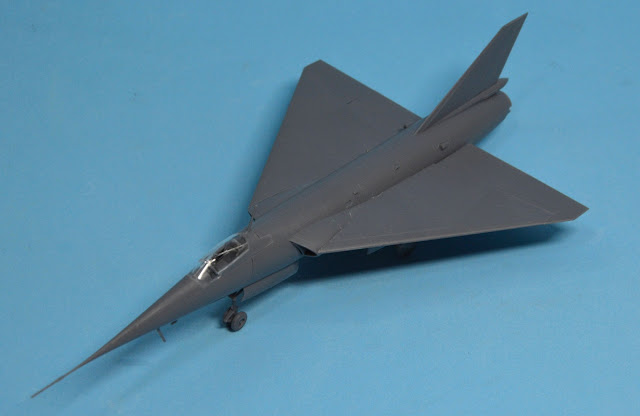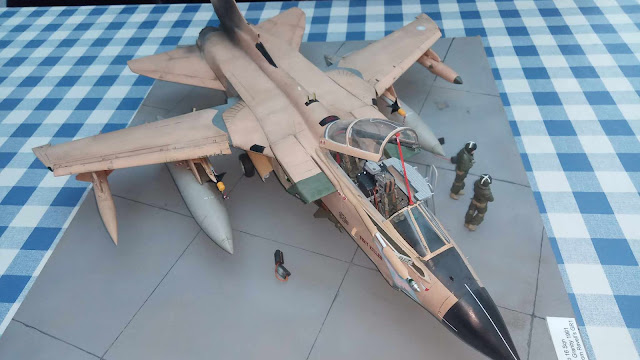Welcome to my blog! I'm an aircraft enthusiast, ex-airline dispatcher, published aviation author and humble 'kit assembler'. I do try and post regularly. On the bench currently - the new-tool 1:48th Airfix Jaguar GR.1
Saturday, 11 November 2023
new-tool Airfix 72nd Me 410 - first look at the sprues, Telford Scale Model World 2023
Wednesday, 11 October 2023
Typhoon Mk IB - R8893, 182 Sqd, Nov 1942 - Airfix 24th scale Typhoon 'Car Door'
A new attendee of the East Kent Scale Modellers group is Tom Le M.. His latest model was photographed on display at our last club night.
" At long last! It is done! 1:24 Hawker Typhoon Mk.Ib Car Door - R8893, 182 Squadron, November 1942. It has been a crazy ride with a lot of firsts! I definitely fell in love with this kit. My painting skills not being as good as some modellers' out there, many mistakes were made and can't count how many times I very nearly gave up, right up to the end. So my Typhoon isn't perfect, but I think I gave it a damn good shot! I learned an awful lot in the process so the next one should be even better (whenever that will be).."
From the Wingleader Typhoon 'Photo Archive book 16' ( a copy in evidence in the pic below of Tom's work bench)
After six weeks of training with the Typhoon IA, 182 Squadron received its first Mk IB with bomb racks, R8893, on 22 October 1942. Photographed a month later it has acquired the codes XM-M and Typhoon special markings as instructed on 19 November 1942. In addition to the white nose and spinner, four black 12-inch stripes were applied chordwise under the wings, starting at the wing root and spaced 24 inches apart. The cannon barrels have canvas covers. One of the first Typhoons modified to carry bombs, R8893 displays the short-lived white nose and black under-wing stripes. Note also the cannon with recoil springs mid-barrel. As with most Typhoons at this time it has the extended exhaust stubs. The aircraft also wears the overwing yellow ‘Dieppe’ stripes. Seen at RAF Martlesham Heath.
Wednesday, 4 October 2023
Roden Fokker Dr. 1 72nd Jasta 12 Fw. Ulrich Neckel
The Roden kit is nice enough - quite detailed including separate sets of ailerons but very fiddly with its minuscule parts, including the internal cockpit framework and all the struts as separate parts, none of which have decent locating holes. I notice that sites such as Scott's 'Modelling Madness' have only ever done an in-box review of this kit. Which is pretty useless really - its not until you get into the build that you realise that some things are awry; eg the decals which are slightly over-sized and don't fit! Not to mention disintegrate on being moved from the backing paper. Fortunately there were two sets in my box - and one appeared to have been reprinted to the right dimensions (?).
Fantastic box-art by the way. And lots of choices on the large decal sheet. Mine is finished in the markings of Fw. Ulrich Neckel of Jasta 12 with typical black rear fuselage and tailplane and 'dirty' white cowl and standard streaked finish over the rest of the airframe. Neckel was born 1898 and was one of the last winners of the Pour Le Mérite, awarded in his case in November 1918 for around 29 victories. He died in 1928 from TB.
Also on this blog;
Lt Paul Bäumer's Jasta Boelcke Fokker Dr. 1 204/17 (SMER 1:44th)
Monday, 18 September 2023
Dora Wings Fairy Delta FD 2 in 72nd - sprue shot, test build and reference pics
Below; nice view of the legendary Fairey Delta 2 WG 774 preparing for a demonstration flight at the Farnborough Air Show c1954. The first FD.2 WG 774 made its first flight on 6 October 1954 with Peter Twiss at the controls. Flight testing continued until 17 November 1954 when during Twiss' 14th flight the engine failed and Twiss - with superb calm headedness - had to land a powerless machine, there being only enough hydraulic pressure to lower the nosewheel.. On 15 February 1956 the second FD 2 WG 777 made its first flight in the hands of Peter Twiss. Althugh both FD 2s carried service roundels neither saw service with the RAF. From the outset Twiss had felt that the type was capable of exceeding 1,000 mph and started calling for an attempt on the world air speed record then held by a F-100 Super Sabre at 822 mph..
Outpacing the Sun' Fairey FD.2 Booklet 1956
A large 32 page booklet produced by Fairey in co-operation with the 'Aeroplane' magazine telling the full story of the Fairey FD.2 attaining the absolute World Speed Record of 1,132 mph in March 1956. The story of the man who flew it, the men who built and designed it and how a speed of 20 miles a minute was measured at over 7 miles above the earth. Sample pages shown.
Fairey Delta 2 WG 774 remains one of the most important aircraft in British aviation history, being the original delta wing jet, and the first aircraft to exceed 1,000 mph. ( Aircraft set new record speed of 1,132 mph on 10 March 1956 ) The British Aircraft Corporation BAC Type 221 was a reconfiguration of the record breaking Fairey Delta 2 into a test bed to test the wing shape of Concorde. First flown as the Type 221 in May 1964, WG 774 spent a further nine years on test flying before being retired in June 1973.
Academy P-47 D Lt. Duane Buholz 509th FS/ 405th FG
P-47 D 'G9-J' in the markings of Lt. Duane Buholz 509th FS/ 405th FG from the Academy 'bubbletop' kit. Seen alongside the Revell kit. Neither satisfactorily represents a P-47 in my view, although the Academy model - like most of this company's 72nd kits- looks least like the real thing. Gear legs are cut down, wheels replaced with resin Pavla items. The canopy is wrong and too 'bulbous' but at least the decals worked.
Originally established as the 405th Bombardment Group (Dive) the unit was re-designated 405th FG in May 1943. Its three squadrons - the 509th, the 510th and the 511th – were coded ‘G9’, ‘2Z’ and ‘K4’ respectively. The unit under CO Col. James Ferguson departed South Carolina in February-March 1944 and was based in Christchurch, southern England, beginning operations with the 9th AF in April 1944 bombing airfields, bridges and rail hubs and installations up until D-day. The 405th FG began the Normandy campaign on June 6, 1944, by escorting Coastal Command aircraft patrolling the Bay of Biscay to prevent any enemy vessels based at the Atlantic ports from reaching the Channel. From June 10 onwards, the 405th FG flew a series of bombing and armed reconnaissance missions in the Cherbourg region. Ground targets ahead of the advancing armour and infantry were pounded relentlessly. Few Luftwaffe fighters were encountered by the pilots, but occasionally there was a confrontation, usually below ten thousand feet.
On 11 July 1944, the 405th FG left its base in Christchurch, England, for good to move to the A-8 advanced airfield at Picauville in Normandy. The 405th FG was the 8th fighter group of the 9th Air Force to land in France. By 31 July, the 9th Air Force had 17 fighter groups in Normandy, supporting 19 American divisions. Most of their missions involved patrols of 6 to 8 aircraft to secure the bridgehead, with aircraft in the air from 6.00 am until 23:40. The 405th FG airfield was 8 km to the west of Sainte-Mère Eglise and just 3 km from the front line. German mortar attacks and snipers in ambush around the ground kept all the group's personnel on high alert. The patrols around the field were regular and at night the men on guard often nervous. The construction of A-8 Field by the 826th Aviation Engineer Battalion had started on 23 June when the sector was still under enemy fire. The runway was the first constructed from bituminised jute matting (Hessian matting). Thanks to this material, the runway was laid in a single day, a record that has never been equalled. Some 75 individual shelters for the P-47s were constructed and 36 for the night fighters who arrived in August onwards. Because of the proximity of the front, take-offs were always to the east, towards Utah Beach. The mist at dawn and dusk, the din of artillery and machine-gun fire were the daily bread of the group throughout its stay in Normandy.
Wednesday, 6 September 2023
1/72 - PZL TS-11 Iskra by Arma Hobby - Iskra Bis DF 'Expert' set build (completed) - Iskra Walkaround
My completed 72nd scale Arma Hobby Iskra. And a small selection of 'walkaround' views of the areas that I felt I needed to see when building the kit, especially the cockpit, the seat, the various 'bumps' around the jet pipe and the foward gear bay. There isn't a forward gear bay in the kit and you really need to build one up from card in order to put the lead weights somewhere and hide them from view. The etch was tricky to work with, especially for the FOD guards which I completely messed up.
Part 1 of this build is posted here
Saturday, 29 July 2023
Italeri 1/32 Tornado built as an 'Op.Granby' Tornado GR 1
This is the Italeri 1/32 Tornado built as ZA 465 'Foxy Killer', an 'Op.Granby' Tornado GR 1 using the Italeri IDS kit as the basis, borrowing appropriate parts from Revell's GR1. This includes parts for the bomb rack and the larger RAF 'Hindenburger' drop tanks. This fine model is featured on the cover of the latest issue of Scale Aircraft Modelling.
Monday, 17 July 2023
Airfix new tool British Army Ferret Scout car - walkaround detail photos
Coming this summer from Airfix in 35th scale is a new-tool British military armour kit - the Ferret Scout car. This example was photographed at the RAF Manston history museum "Skirmish" event on 16 July 2023.
After a successful series of light armoured reconnaissance and liaison vehicles, the Ferret Scout Car saw widespread British and Commonwealth military service from the 1950s onwards, with later variants of the Ferret taking part in the Gulf War of 1990.
A vehicle type which can trace its lineage back to the successful Daimler Dingo scout car of the Second World War, the Ferret was designed with stealth in mind, a light and fast armoured vehicle which could probe enemy positions, reporting any discovered weak points back to commanders, with their own forces moving to exploit what they found.
Weighing in at around 4 tons operational weight, the Ferret was of all welded construction and featured armour protection capable of withstanding most small arms fire, but nothing much heavier, although it was not intended that the vehicle would be operating in direct opposition to heavy enemy armour.
If it did find itself in a bit of trouble, the 4 wheel drive Ferret was powered by a reliable 6 cylinder Rolls Royce engine which gave it a top speed of 45 mph, a speed it could also achieve in reverse if required, something which could prove extremely useful if the crew found themselves in a tight spot.


































.jpg)
.jpg)
.jpg)





.jpg)
.jpg)









